Instana
Instana is an enterprise observability and application performance monitoring tool that relays critical information about the health of your enterprise and cloud-based digital systems. xMatters uses Instana to relay critical information to on-call resolvers, reduce event noise, and automate manual tasks to improve incident response efficiency
This workflow lets you send actionable alerts to on-call resources when xMatters gets a signal from Instana. Responders can initiate an incident with the press of a button, or you can build on the flow to perform automated resolution tasks.
How it works
When an alert is generated in Instana, it sends a JSON-formatted webhook to xMatters, based on the user-defined alert rules. An Instana trigger in xMatters parses the webhook and initiates a flow. The webhook includes essential alert data you can use to enrich notifications to users or when building automated tasks.
Install the workflow
The following instructions describe how to install the workflow through the xMatters one-click installation process.
- Go to the Workflow Templates page and click the Instana tile.
- On the Set up the Workflow tab, give the workflow a name that identifies its purpose (this must be unique in your instance), add an optional description, and set the default incident type (if applicable). Any built-in Initiate Incident steps in the workflow will automatically be set to the selected incident type.
- You can edit these later, if needed.

- You can edit these later, if needed.
- Click Next to set up the connection.
- Choose the authentication method. A trigger URL is generated based on the selected authentication method.
- Copy the trigger URL — you’ll use this to configure the webhook in Instana.
- The trigger URL includes the recipients parameter, which specifies who should be notified. By default, this parameter is set to notify you (the logged in user), but you can set it to target any user or group you want.
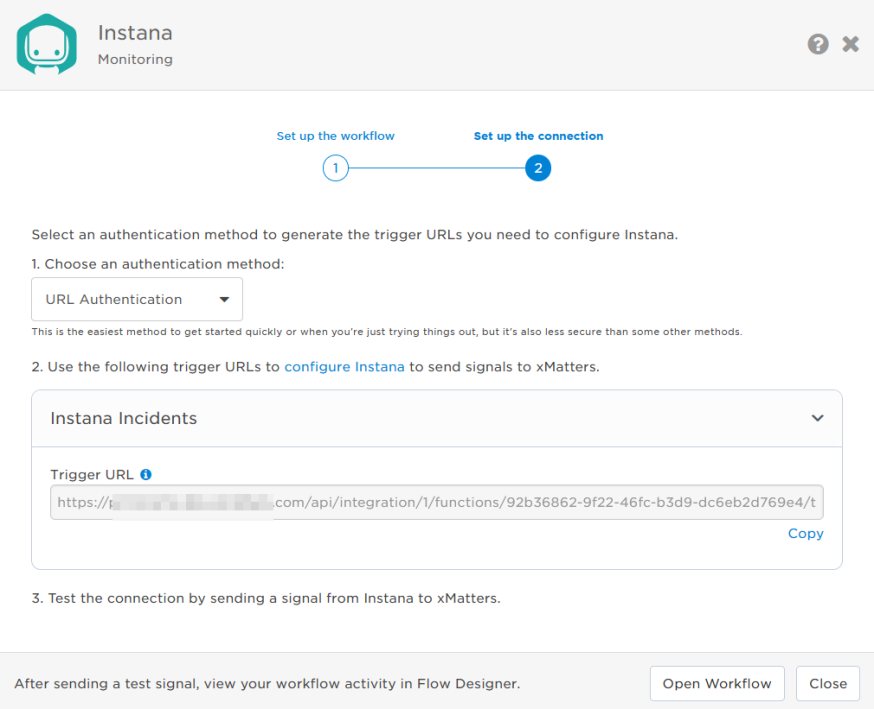
- The trigger URL includes the recipients parameter, which specifies who should be notified. By default, this parameter is set to notify you (the logged in user), but you can set it to target any user or group you want.
- Send a test signal to the trigger URL to test the connection.
- Click Open Workflow to view and customize the workflow, or Close to return to the Workflows page.
Configure Instana to send requests to the trigger URL
To have Instana send alerts to the flow trigger, you need to create an alert channel and set it to use the trigger URL, then create an alert that uses the channel.
Create an integration between Instana and xMatters.
- Install Instana's host agent.
- In Instana, navigate to Settings > Team Settings > Alert Channels.
- Click Add Alert Channel.
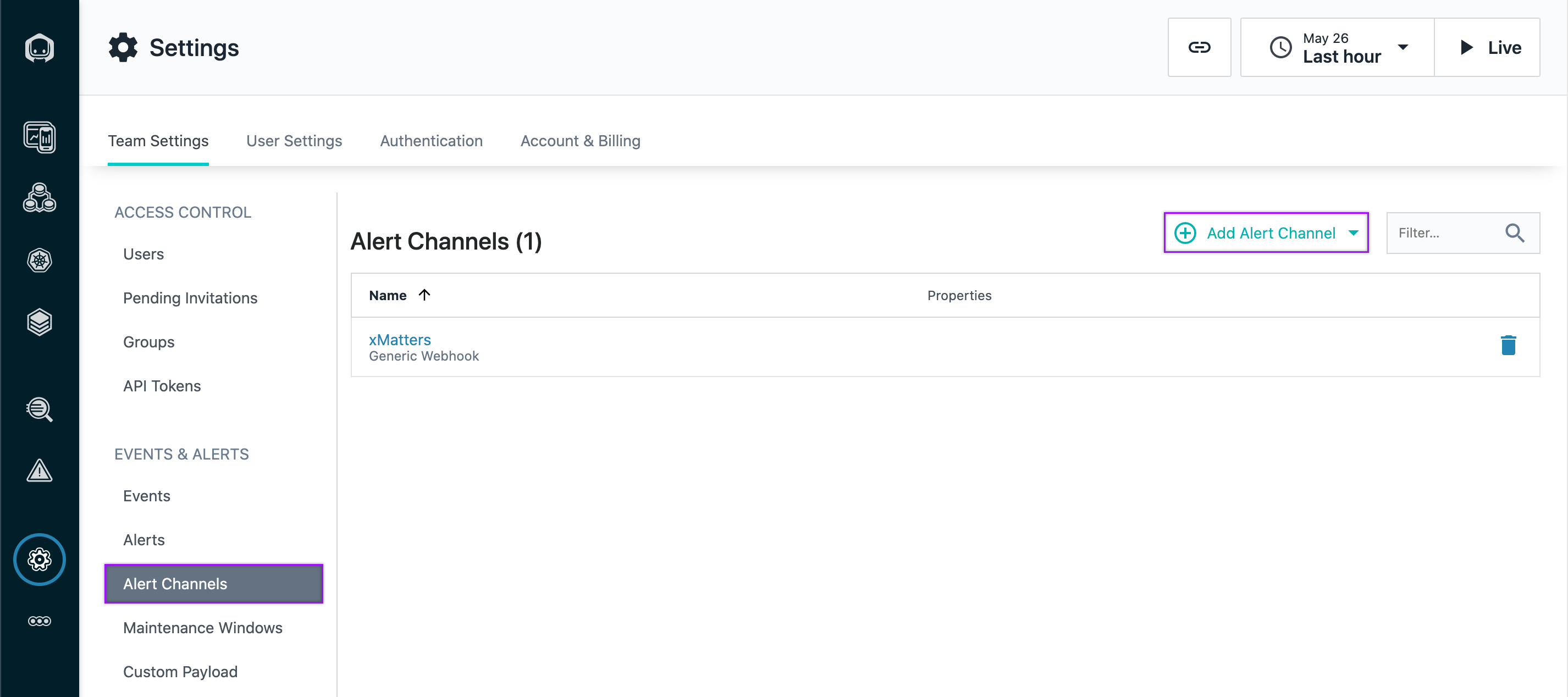
- Give the new alert channel a unique Name.
- In the Webhook URLs field, add the trigger URL you copied from Flow Designer.
- Add the target names of any recipients you want to notify when the alert fires.
- For URL authentication, use an ampersand to attach recipients. For example, if you want to notify Emma Pearson and the on-call members in the group responsible for the Antares service, you'd add &recipients=epearson,antares to the end of the URL.
- For other authentication types, use a question mark to attach recipients. For example, if you want to notify Barry Gull and the on-call members in the group responsible for the Cassiopeia service, you'd add ?recipients=bgull,cassiopeia to the end of the URL.
- You must URL-encode any special characters or spaces in the target names.
- Optional: If you use Basic Authentication, use the Custom HTTP Request Headers section to set the values.
- Set the Key to Authorization
- Set the Value to Basic followed by a Base64 encoded username and password (for example Basic <aBCdeF12g34hiJKL>). You can create a Base64 encoded username and password at https://www.base64encode.org/ or by typing echo “username:password” | base64 into a terminal.
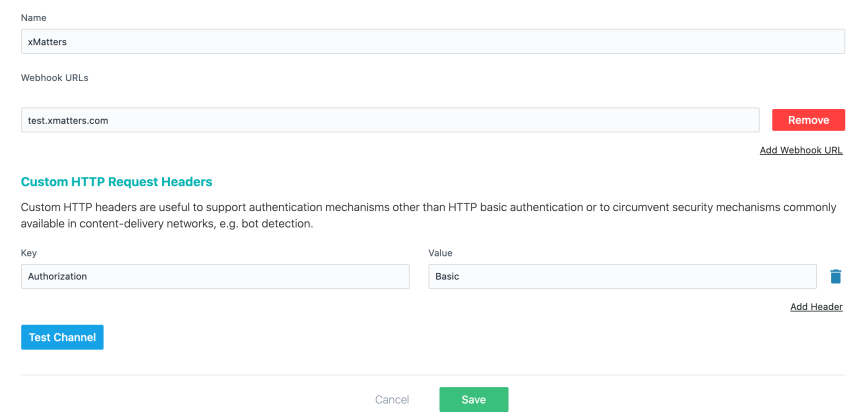
- Optional: Click Test Channel.
- Click Save.
Now that the alert channel is created, you need to create a new alert that defines when you want to receive alerts.
- From the Events & Alerts menu, select Alerts.
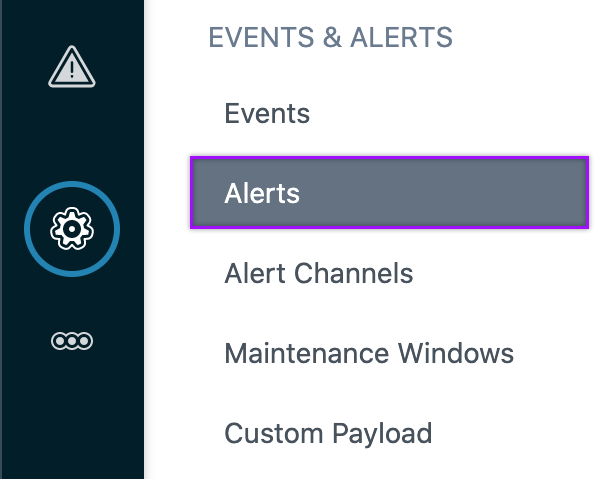
- Click New Alert. The Create New Alert window opens.

- In step 1. Name, give the alert a unique Name.
 .
. - In step 2. Events, use the drop-down to select events or event types you want to receive alerts for.
- In step 3. Scope, use the drop-down to select the scope of entities you want to receive alerts for.
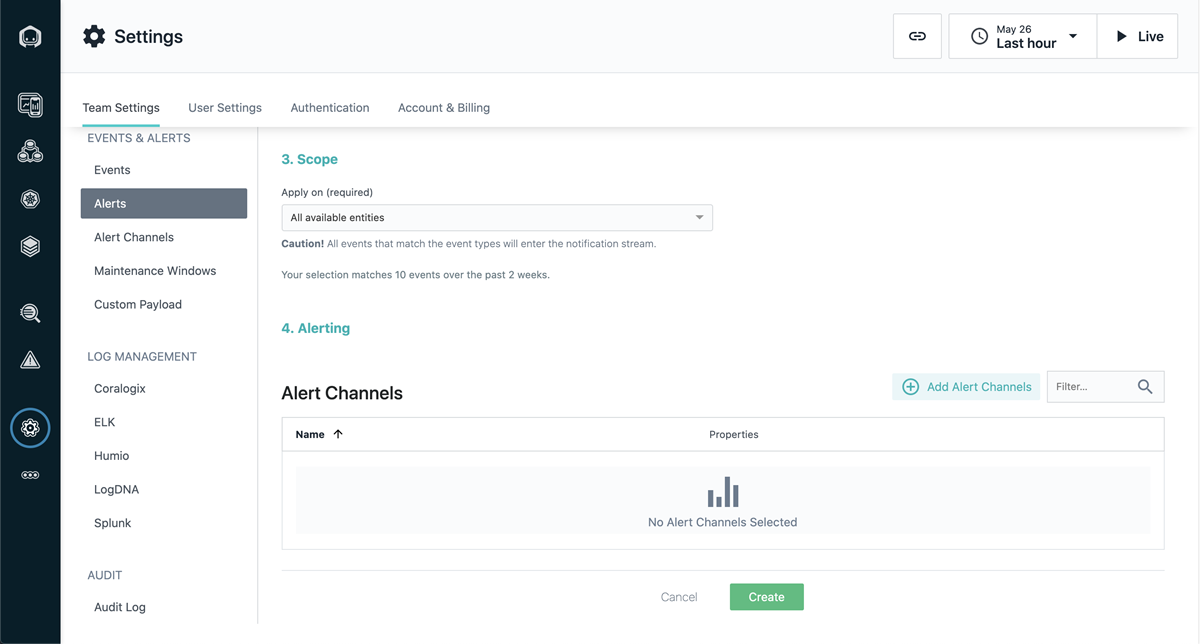
- In step 4. Alerting, click Add Alert Channels.
- Select the xMatters alert channel you just created, then click Add 1 Channel.
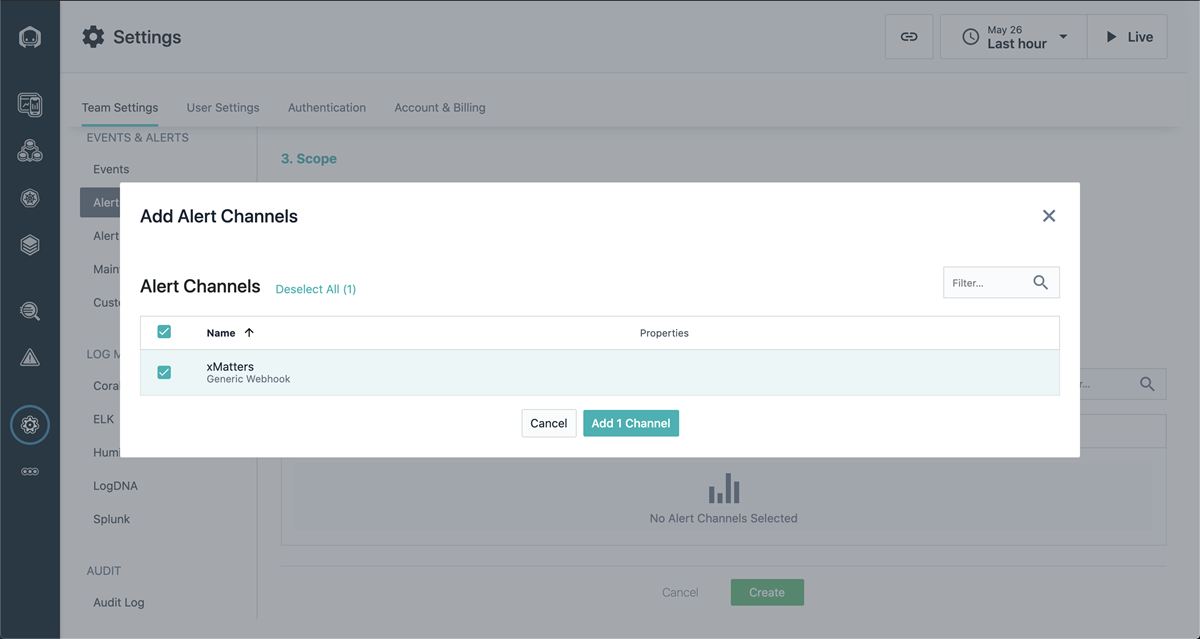
- Click Create.
You're ready to use the webhook to trigger automated flows, including steps such as sending alerts and initiating incidents, though we always recommend testing before putting things into use.
Set recipients in the trigger URL
The trigger expects the recipients in the trigger URL. When you copy the URL from xMatters, it includes the recipients parameter: recipients=<yourname>. Of course, you don’t want to receive all the alerts.
To change the recipients for alerts from this webhook, swap out your name for the people or groups you want to target.
- For URL authentication, use an ampersand to attach recipients. For example, if you want to notify Emma Pearson and the on-call members in the group responsible for the Antares service, you'd add &recipients=epearson,antares to the URL.
- For other authentication types, use a question mark to attach recipients. For example, if you want to notify Barry Gull and the on-call members in the group responsible for the Cassiopeia service, you'd add ?recipients=bgull,cassiopeia to the URL.
Remember to URL-encode any special characters in your group names.
We recommend using groups so you can take advantage of the xMatters group features — rotations, escalations, and absences — to reach the right on-call people to jump on an issue.
How to use the workflow
When an alert rule you’ve set to use the action group fires, it sends a signal to xMatters, which creates an alert and notifies the individual or the on-call members of the groups you set as recipients in the webhook URL.
When a condition you've set fires, it sends a signal to xMatters, which creates an alert and notifies the individual or the on-call members of the people or groups you set as recipients in the webhook URL. When the trigger receives a signal saying the issue is resolved, it automatically terminates related alerts in xMatters.
The person responding to the notification has the following response options:
- Acknowledge: Acknowledges the notifications and stops escalations.
- Escalate: Immediately escalates the alert to the next on-call resolver in a targeted group.
- Close: Ends the xMatters alert and stops notifying all targeted recipients.
- Initiate Incident: Initiates an incident in xMatters.
Next Steps
Now that you've installed the workflow, you can use it as-is, or customize it to suit your needs better. Here are some examples of things you can add to the workflow to customize it:
- Use Slack, Zoom, and Microsoft Teams steps to add collaboration channels to the flow.
- Change the severity of incidents created when a recipient selects the Initiate Incident response.
- Update the message sent to resolvers to include the information most relevant to your team.
- Use the Instana Incidents trigger to build your own custom flows.
